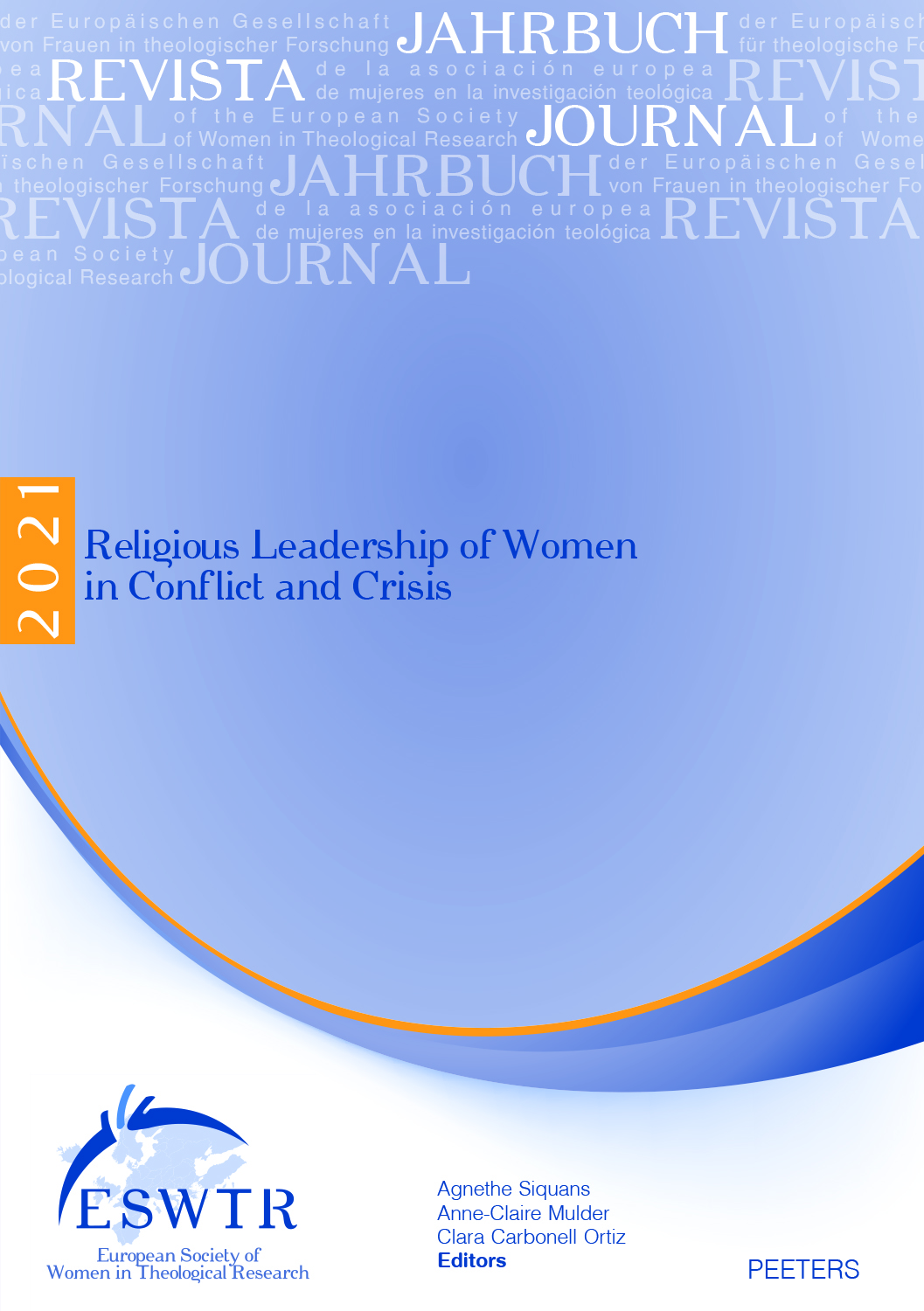 previous article in this issue previous article in this issue | next article in this issue  |

Preview first page |
Document Details : Title: 'Partners in Crime' Subtitle: Dissident Male and Female Religious Leaders of the Clandestine Catholic Church in the Dutch Republic (1570-1800) Author(s): HOFSTEE, Sytske Journal: Journal of the European Society of Women in Theological Research Volume: 29 Date: 2021 Pages: 31-59 DOI: 10.2143/ESWTR.29.0.3289660 Abstract : During the early modern period, over 5000 spiritual virgins were active in Catholic communities in the Republic of the Seven United Netherlands. This paper explores the religious leadership of early modern Catholic women during the crisis period of the Catholic Church in the Dutch Republic. The paradigm of the 'priest-assistant' appears to be dominant in church historical studies, and therefore little attention has been paid to leadership positions of these Catholic (semi-religious) women. The paradigm emphasizes the domestic or serving function of spiritual virgins and ignores the motivations of early modern women themselves, in particular their choice of becoming 'bride of Christ'. Spiritual unity was the ultimate goal, as they put their lives in the service of Christ and, in the situation of the Republic, at the service of the oppressed and crisis-ridden Catholic faith community. In this article, I elaborate the concept of religious leadership in relation to Catholicism and give an outline of both female and male religious leadership in the aforementioned period within the Dutch context. This context was defined by the unusual mix of, on the one hand prohibition and persecution and, on the other hand, toleration of Catholics by the authorities, a mix that affected the practices of Catholic leadership. I use the double-voice agency concept to understand forbidden voices of female, as well as male Catholics in a framework of dissimulation. Finally, I present a number of leadership examples from the province of Friesland to demonstrate that spiritual virgins and lay women in different settings have led Catholic faith communities in various innovative ways and ensured the survival of Catholicism in times of crisis and conflict. In der frühen Neuzeit waren über 5000 spirituelle Jungfrauen in den katholischen Gemeinden in der Republik der sieben vereinigten Niederlande aktiv. Dieser Beitrag untersucht die religiöse Leitung von frühneuzeitlichen katholischen Frauen während der Krisenzeit der katholischen Kirche in der holländischen Republik. In kirchenhistorischen Studien scheint das Modell der 'Priester-Assistentinnen' dominant zu sein. Daher fanden Leitungspositionen dieser katholischen (semi-klerikalen) Frauen wenig Aufmerksamkeit. Das Modell betont die häuslichen und dienenden Funktionen der spirituellen Jungfrauen und ignoriert die Motivationen dieser frühneuzeitlichen Frauen selbst, besonders ihre Entscheidung, 'Braut Christi' zu werden. Spirituelle Einheit war das letzte Ziel, wenn sie ihr Leben in den Dienst Christi stellten und, in der Situation der Republik, in den Dienst der unterdrückten und krisengeschüttelten katholischen Glaubensgemeinschaft. In diesem Artikel führe ich das Konzept religiöser Leitung in Beziehung zum Katholizismus aus und präsentiere eine Skizze sowohl weiblicher als auch männlicher religiöser Leitung in der zuvor genannten Zeit im holländischen Kontext. Dieser Kontext war definiert durch eine ungewöhnliche Mischung des Verbots und der Verfolgung einerseits und Toleranz gegenüber Katholik*innen durch die Autoritäten andererseits, eine Mischung, die sich auf die Praxis katholischer Leitung auswirkte. Ich verwende das Konzept der double-voice agency (Handlungsmacht der doppelten Stimme), um die verbotenen Stimmen weiblicher sowie männlicher Katholiken in einem Kontext der Verstellung zu verstehen. Zuletzt präsentiere ich einige Beispiele von Leitung aus der Provinz Friesland, um zu zeigen, dass spirituelle Jungfrauen und weibliche Laien in unterschiedlichen Situationen katholische Glaubensgemeinschaften in verschiedenen innovativen Weisen geleitet und das Überleben des Katholizismus in Zeiten von Krise und Konflikt sichergestellt haben. Durante la Edad Moderna, alrededor de cinco mil vírgenes espirituales estuvieron activas en las comunidades católicas de la República de los Siete Países Bajos Unidos. Este artículo explora el liderazgo religioso de las mujeres católicas de este período durante la crisis de la Iglesia Católica en los Países Bajos. El paradigma del 'sacerdote-asistente' aparece como dominante en los estudios eclesiásticos históricos y, por ello, se ha prestado poca atención a las posiciones de liderazgo de estas mujeres católicas (semirreligiosas). El paradigma enfatiza la función doméstica o servicial de las vírgenes espirituales e ignora las motivaciones de dichas mujeres, en particular su elección de convertirse en 'esposas de Cristo'. La unidad espiritual era la meta final, pues pusieron sus vidas al servicio de Cristo y, en lo que respecta a la República, al servicio de aquella comunidad de fe católica oprimida y arrasada por la crisis. En este artículo, elaboro el concepto de 'liderazgo religioso' en relación con el catolicismo y delineo tanto el liderazo femenino como el masculino en el período mencionado para el contexto neerlandés. Dicho contexto estaba definido por la mezcla insual entre, por un lado, la prohibición y la persecución y, por otro, la tolerancia hacia los católicos por parte de las autoridades; mezcla que afectó a las prácticas de liderazgo religioso. Uso el concepto de la 'agencia de doble voz' para entender las voces prohibidas de las mujeres así como de los hombres católicos en un marco de disimulo. Finalmente, presento un número de ejemplos sobre el liderazgo en la provincia de Friesland para demostrar que las vírgenes espirituales y las mujeres laicas de diferentes escenarios dirigieron comunidades de fe católicas de diversas e innovadoras maneras, y aseguraron la supervivencia del catolicismo en tiempos de crisis y conflicto. |
 |


